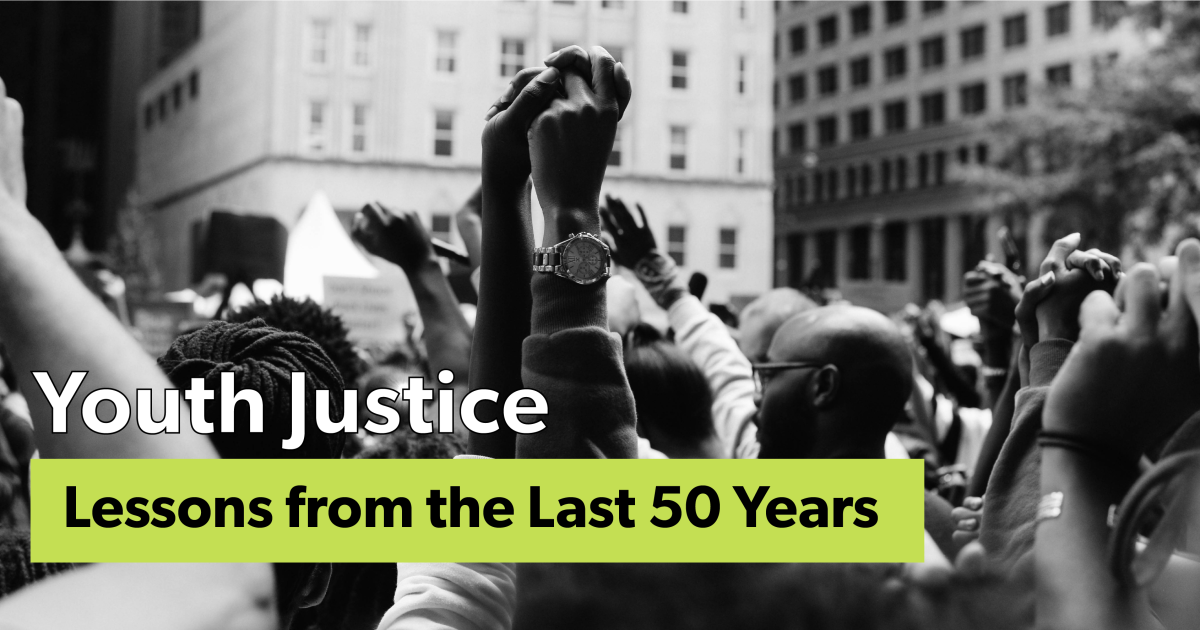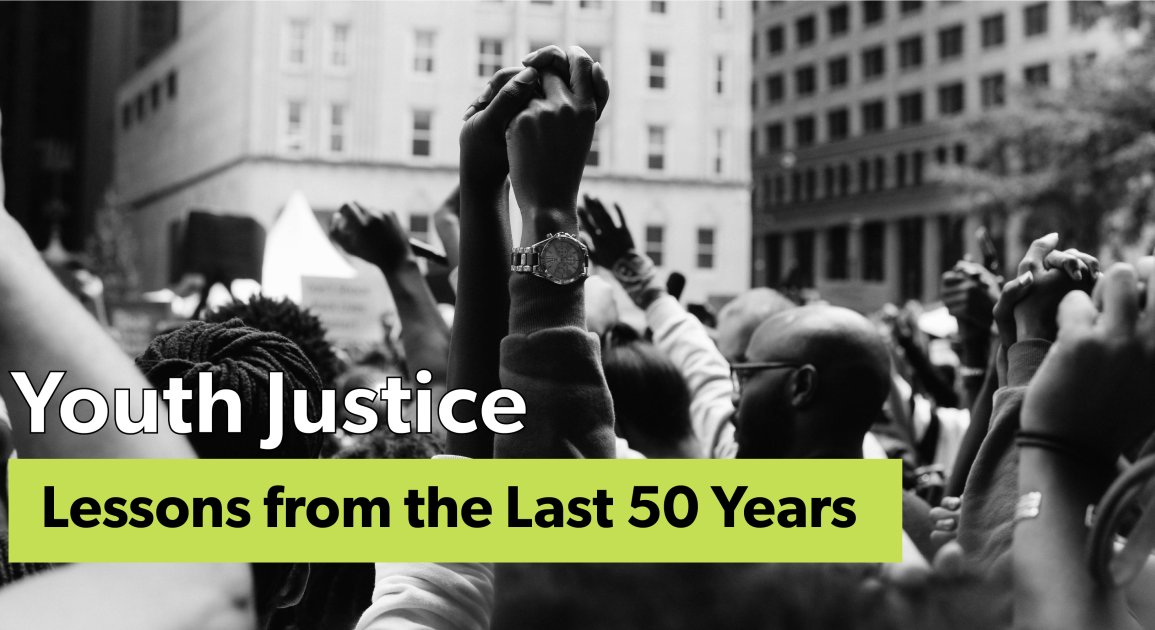
Introduction
Reports of increased crime — whether backed by evidence or merely anecdotal — ought to lead anyone who cares about youth justice to worry. In the late 1980s and early 1990s, increases in youth offending and changes in policy led to vastly more teenagers sent to adult prisons and jails as well as juvenile facilities. Pundits, ignorant of the harshness already embedded in the system, claimed even more incarceration was needed or teen crime would only accelerate.
In those years, constituents’ fears led and politicians followed. Today, we have ample evidence — evidence that 1990s leaders did not — that harsh responses to teens’ poor decisions fail. Teenagers make bad choices because they’re teenagers. They’re immature. They’re impulsive. They’re unduly influenced by their peers. But what excuses do adults have when they, too, prove themselves swayed by media narratives and cherry-picked anecdotes?
With the benefits of hindsight, we can see the predicted carnage did not arrive; instead, youth offending began a long decline. Drops in youth arrests then coincided with drops in youth incarceration. Over the course of the 21st century, locking up fewer kids hasn’t resulted in more crime; it’s been followed by less crime.
A Better Approach
The current era of juvenile justice reform is built around a better understanding of adolescent development, limiting out-of-home placement and keeping more young people out of criminal courts designed for adults. More than half of states have redefined their juvenile justice systems’ statutorial purposes since 2000, mostly away from punitive visions.
These aren’t new ideas, nor are they particularly innovative. Decades of research, along with documentation of the horrors of youth placement, confirm that America locks up too many of its young people. No other country does so nearly as often.
Over the course of the 21st century, locking up fewer kids hasn’t resulted in more crime; it’s been followed by less crime.
The commonsense vision is often aspirational — the system’s footprint remains enormous, and indefensible racial and ethnic disparities pervade — though successes are plentiful. There are far fewer court-involved youth today than 25 years ago, and far fewer harmful facilities in operation.
The history of justice reform, marked by waves and retreats barely connected to actual teen offending, reveals how precarious it can be. Given the growing political rhetoric that flame public fears about crime and criticize reform, is the current era of reform politically sustainable?
The Rise and Fall of Youth Incarceration
The mid-1970s, the start of the era of mass incarceration, also witnessed the passage of the federal Juvenile Justice and Delinquency Prevention Act (JJDPA) in 1974, which established the Office of Juvenile Justice and Delinquency Prevention (OJJDP). The JJDPA was built on the understanding that “youth who offend should be treated differently and separately from adults who offend, that juvenile offending is preventable, and that youthful offenders should receive individualized treatment and services.” The establishment of an autonomous office symbolized heightened concern over a flawed system.
The JJDPA fit neatly in with a set of due process improvements. That era started with the Supreme Court’s In re Gault ruling that rejected a paternalistic vision of juvenile justice that believed courts and juvenile detention centers could supplant a child’s own parents, even for misbehavior as trivial as crank phone calls. Prior to the JJDPA’s passage, a very high proportion of those who were in facilities were accused of nothing more than a status offense., Experts described a consensus limiting the training schools and youth prisons for the most serious and violent cases.
Twenty years later, with youth offending and arrests on the rise, many believed the juvenile justice system’s alleged leniency was to blame and that juvenile courts were incapable of addressing the problems. Political scientist John DiIulio predicted a “demographic crime bomb” of “remorseless super-predators” and (along with urging more religious piety) argued that the nation “will have little choice but to pursue genuine get-tough law-enforcement strategies against the super-predators.”
Contrary to his imagined lenient system, DiIulio’s wish had already been granted. There were about 4,000 people under 18 in adult prisons and jails as of 1985, a count that more than tripled by 1995 — a massive increase in years that youth arrests grew 36%. More than six out of every ten incarcerated youths were confined in an overcrowded facility.
Other data suggest criminalization of adolescence was already underway as well. True, arrests for the most serious offenses grew 79% from 1985 to 1995. But those increases were matched or exceeded by increases in youth arrests for disorderly conduct (up 84%), curfew and loitering (up 84%), and drug offenses, (up 110%), timeless hallmarks of youth that are significantly (and thankfully!) more common than violent offenses. Then as now, many arrests reflected law enforcement’s and politicians’ choices to criminalize adolescence rather than adolescents’ criminal behaviors, particularly when the adolescents were Black or brown.
Throughout the 80s and 90s, states passed laws to encourage more placements, built cruel boot camps, and sent more youth into adult courts, jails, and prisons. Youthfulness, instead of being seen as a rationale for temperance, was argued as a reason for fear. In 1994, seeking to execute Christopher Roper, Missouri prosecutors argued, “Seventeen years old. Isn’t that scary? Doesn’t that scare you? Mitigating? Quite the contrary I submit. Quite the contrary.”
A Turned Tide
In 2001, with crime falling, DiIulio publicly renounced his super-predator theory, recognizing its many, many flaws. Christopher Roper’s death sentence was overturned by 2005’s Supreme Court, which found the death penalty to be a disproportionate punishment for people under 18-years old: immaturity diminishes their culpability, as does their susceptibility to outside pressures and influences. That same year, the Campaign for Youth Justice was founded to protect youth from the ravages of the adult criminal justice system, and succeeded in its “raise-the-age” campaigns in states from Massachusetts to Michigan to Missouri and beyond. The Annie E. Casey Foundation and MacArthur Foundation led the donor community with a long-term investment to find and fund new, common-sense, non-carceral solutions.
Youth offending dropped during these years, bolstering the impact of the reforms. Returning 16- and 17-year olds to youth-serving courts cost far less than policymakers had anticipated. Self-reported survey data showed less criminal behavior from high schoolers, reflected in indicators such as fights and illicit drug use. From 2000 to 2020, youth arrests fell 80% and youth placements in the juvenile system fell 77%.
Still, the complex maze of harsh laws and policies passed in the 1980s and 1990s has proven stubbornly difficult to unwind even as youth offending has fallen dramatically since those years. Many states rolled back their laws, but many others remain unchanged.
Lessons for the Adult System
This century’s rapid drops in youth incarceration are hard to replicate for adults. Youths under supervision (whether probation or placement) typically age out of the jurisdiction of their state’s juvenile courts at age 21. Emptying a bathtub requires opening the drain and turning off the water, and opening the drain is vastly easier in the juvenile system as young people age out of its jurisdiction.
In the adult system, extreme sentences, such as life without the realistic possibility of parole, leave far too many people locked up for decades-old crimes, even when those crimes were committed in adolescence. On the other hand, teenagers — as long as they are not sentenced as if they were adults — age out of juvenile supervision. The feedback loop is much faster, allowing for rapid decarceration as reforms take hold and offending drops.
Despite key differences between criminal and juvenile justice, the youth system’s successes point to a clear pathway to close the book on adult mass incarceration, as well: less reliance on incarceration initially and more opportunities for release for those who are incarcerated.
What’s Next?
Political pressures may force an end to this era of effective reform. For years, polling has consistently found most Americans believed crime was increasing (even as it fell), so it’s not clear that seeing that proportion increase from 65% to 75% ought to decimate what’s working. But new laws will encourage more pre-trial detention of arrested youth (in the District of Columbia and Kentucky) and others will build more youth prisons (in Louisiana, and Texas, for example). The Annie E. Casey Foundation is finding longer lengths of stay — for youth of color — at hundreds of detention centers across the country. We know those ideas won’t work; they’ve been tried already. For 50 years, politics has been a relentless opponent.
We know that incarceration damages both public safety and the well-being of the incarcerated child. We know that charging youth in adult courts makes it more likely that they will reoffend. We know that teen curfews and other aggressive policing do not reduce crime and probably increase it.
The leaders of the 1990s did not know these things with certainty, but after mass incarceration’s 50 years of failures, we can all look at the evidence: a shrunken system is better for us all.
Despite key differences between criminal and juvenile justice, the youth system’s successes point to a clear pathway to close the book on adult mass incarceration.
This post was originally published on this site be sure to check out more of their content.







